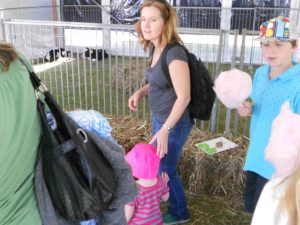Although trained in molecular biology, genetics and food science, I always had a desire to additionally express my creativity as a writer. In 1986I put aside my fears and made my way to the second floor of the university centre, home to all things student, including the University of Guelph student newspaper, The Ontarion.
 I approached the editor-in-chief, who had issued a call for additional writers, and boldly – it seemed bold at the time – said. I want to write.
I approached the editor-in-chief, who had issued a call for additional writers, and boldly – it seemed bold at the time – said. I want to write.
But rather than do record reviews or movie reviews, which everyone wanted to write, I said I want to write about science. I was a MSc student at the time.
After a few published pieces, I was awarded a weekly science column. The next year, through a series of weird events, I became editor-in-chief and lost interest in grad school (or was it the other way around?).
For a newbie journo, it was a struggle to come up with a weekly column while running my experiments to understand the basis of disease resistance –Verticillium wilt – in tomatoes.
My cats led the way.
My first warm-blooded pets – whom I named Clark and Kent — had been provided by my veterinary student girlfriend. I became fascinated with cat behavior, and thought the 25,000 potential readers would share my cat voyeurism.
Some did, enough to secure my weekly column and write about other sciencey things.
Researchers from the Centers for Disease Control and Prevention, Atlanta, Georgia, (B. Breedlove) and the British Library, London, UK (J. Igunma) write in the Dec. 2020 issue of Emerging Infectious Diseases that Felis catus, the only domesticated species of cat in the family Felidae, flourishes on every continent except Antarctica. Able to thrive in almost any climate and habitat, it is among the world’s most invasive species. Current estimates of the global cat population, including pet, stray, and feral cats, range from 200 million to 600 million. Where there are humans, more than likely there are also cats.
Humans living in agricultural villages in northern Africa and the Near East are believed to have domesticated the African wildcat (Felis lybica) between 8,000 to 12,000 years ago. Archaeologist Magdalena Krajcarz and colleagues noted, “The cat’s way to domestication is a complex and still unresolved topic with many questions concerning the chronology of its dispersal with agricultural societies and the nature of its evolving relationship with humans.” Likely stored grains and trash piles in villages attracted rodent pests, which in turn lured local wildcats and initiated a nascent mutualistic relationship that has since flourished.
From those villages, cats found their way around the world. Authors Lee Harper and Joyce L. White wrote that ancient sailors “were quick to see the advantage of having cats aboard ship during long voyages to protect their food supplies from damage by rodents.” Trade and commerce helped spread cats from the Middle East to various ports of call in Europe, the Far East and Orient, and the Americas. Throughout this common history, cats have been both reviled and revered by humans.
During the Middle Ages in Europe, some religious institutions considered cats evil, leading to thousands being killed. Later, however, the Black Death spread by fleas on rats contributed to cats’ redemption. Harper and White noted, “The cat’s skill as a hunter of vermin was desperately needed. Its reputation was salvaged. Owning a cat was back in style.”
 Ancient Egyptians ascribed to cats many characteristics shared with deities they worshipped. Freyja, Norse goddess of love, beauty, and fertility, rode on a cat-drawn chariot. Temples in medieval Japan often kept a pair of cats to protect precious manuscripts from being ruined by mice. In the Kingdom of Siam, which is modern-day Thailand, Buddhist monks welcomed cats into their temples, where they were protected as Maeo Wat (Temple Cats).
Ancient Egyptians ascribed to cats many characteristics shared with deities they worshipped. Freyja, Norse goddess of love, beauty, and fertility, rode on a cat-drawn chariot. Temples in medieval Japan often kept a pair of cats to protect precious manuscripts from being ruined by mice. In the Kingdom of Siam, which is modern-day Thailand, Buddhist monks welcomed cats into their temples, where they were protected as Maeo Wat (Temple Cats).
This month’s cover art, “two lucky cats to support leadership,” is the second folio from A Thai Treatise on Cats, created in the 19th century in central Thailand and acquired by the British Library in 2011. Such manuscripts about cats were made for breeders in Thailand at least from the 18th century on, although it is believed that cat breeding goes back to the beginnings of the ancient Thai Kingdom of Ayutthaya in the 14th century.
The positive side of cat ownership, as celebrated in those cat treatises, is acknowledged on the CDC website, “Research has shown that cats can provide emotional support, improve moods, and contribute to the overall morale of their owners. Cats are also credited with promoting socialization among older individuals and physically or mentally disabled people.” Cats, as noted earlier, have also historically helped control the spread of rodent-borne diseases among humans.
Nonetheless, living in close quarters with cats carries some health risks. Cats can transfer various zoonotic diseases, including Campylobacter infection, cat–scratch disease, cryptosporidiosis, hookworm infection, plague, rabies, and salmonellosis. Cats are the only animal in which the Toxoplasma gondii parasite completes its life cycle, and humans in close contact with cat litter, for example, are at risk of developing toxoplasmosis, which pregnant women can potentially transmit to a fetus. Much less common is transfer of disease from humans to animals, such as the suspected case of human-to-cat transmission of severe acute respiratory syndrome coronavirus 2 reported in this issue. (Both owner and cat recovered.)
Detecting, responding to, and preparing for emerging zoonotic infections―which, like cats, have made their way around the world with our help―are major challenges for public health leaders. Even if cats are not actual talismans or have the power to improve leadership, spending a few minutes considering these lucky cats may provide public health officials a brief respite or serendipitous insight.
In consideration of our mutual relationship with cats
Emerging Infectious Diseases, vol. 26 no. 12
Byron Breedlove and Jana Igunma








